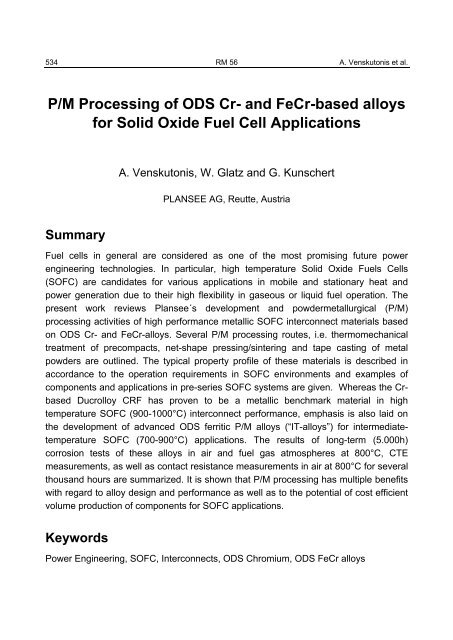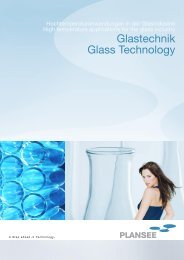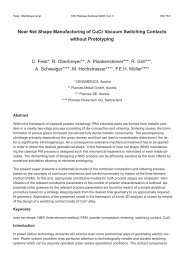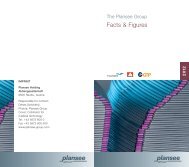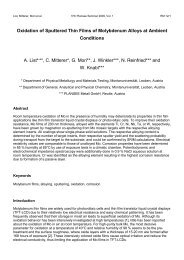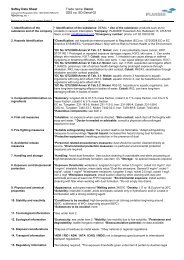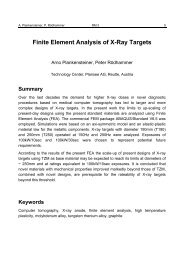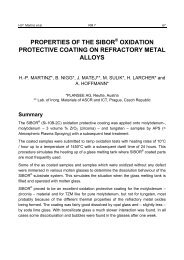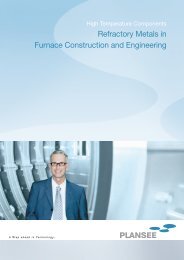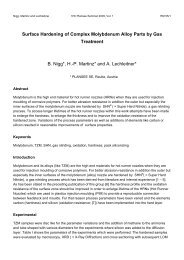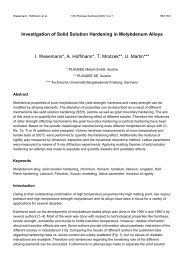P/M Processing of ODS Cr- and Fecr-based alloys for Solid Oxide ...
P/M Processing of ODS Cr- and Fecr-based alloys for Solid Oxide ...
P/M Processing of ODS Cr- and Fecr-based alloys for Solid Oxide ...
You also want an ePaper? Increase the reach of your titles
YUMPU automatically turns print PDFs into web optimized ePapers that Google loves.
534 RM 56 A. Venskutonis et al.<br />
P/M <strong>Processing</strong> <strong>of</strong> <strong>ODS</strong> <strong>Cr</strong>- <strong>and</strong> Fe<strong>Cr</strong>-<strong>based</strong> <strong>alloys</strong><br />
<strong>for</strong> <strong>Solid</strong> <strong>Oxide</strong> Fuel Cell Applications<br />
Summary<br />
A. Venskutonis, W. Glatz <strong>and</strong> G. Kunschert<br />
PLANSEE AG, Reutte, Austria<br />
Fuel cells in general are considered as one <strong>of</strong> the most promising future power<br />
engineering technologies. In particular, high temperature <strong>Solid</strong> <strong>Oxide</strong> Fuels Cells<br />
(SOFC) are c<strong>and</strong>idates <strong>for</strong> various applications in mobile <strong>and</strong> stationary heat <strong>and</strong><br />
power generation due to their high flexibility in gaseous or liquid fuel operation. The<br />
present work reviews Plansee´s development <strong>and</strong> powdermetallurgical (P/M)<br />
processing activities <strong>of</strong> high per<strong>for</strong>mance metallic SOFC interconnect materials <strong>based</strong><br />
on <strong>ODS</strong> <strong>Cr</strong>- <strong>and</strong> Fe<strong>Cr</strong>-<strong>alloys</strong>. Several P/M processing routes, i.e. thermomechanical<br />
treatment <strong>of</strong> precompacts, net-shape pressing/sintering <strong>and</strong> tape casting <strong>of</strong> metal<br />
powders are outlined. The typical property pr<strong>of</strong>ile <strong>of</strong> these materials is described in<br />
accordance to the operation requirements in SOFC environments <strong>and</strong> examples <strong>of</strong><br />
components <strong>and</strong> applications in pre-series SOFC systems are given. Whereas the <strong>Cr</strong><strong>based</strong><br />
Ducrolloy CRF has proven to be a metallic benchmark material in high<br />
temperature SOFC (900-1000°C) interconnect per<strong>for</strong>mance, emphasis is also laid on<br />
the development <strong>of</strong> advanced <strong>ODS</strong> ferritic P/M <strong>alloys</strong> (“IT-<strong>alloys</strong>”) <strong>for</strong> intermediatetemperature<br />
SOFC (700-900°C) applications. The results <strong>of</strong> long-term (5.000h)<br />
corrosion tests <strong>of</strong> these <strong>alloys</strong> in air <strong>and</strong> fuel gas atmospheres at 800°C, CTE<br />
measurements, as well as contact resistance measurements in air at 800°C <strong>for</strong> several<br />
thous<strong>and</strong> hours are summarized. It is shown that P/M processing has multiple benefits<br />
with regard to alloy design <strong>and</strong> per<strong>for</strong>mance as well as to the potential <strong>of</strong> cost efficient<br />
volume production <strong>of</strong> components <strong>for</strong> SOFC applications.<br />
Keywords<br />
Power Engineering, SOFC, Interconnects, <strong>ODS</strong> Chromium, <strong>ODS</strong> Fe<strong>Cr</strong> <strong>alloys</strong>
A. Venskutonis et al. RM 56 535<br />
1. Introduction<br />
The requirements <strong>for</strong> suitable interconnect components <strong>of</strong> planar SOFC are<br />
challenging due to the influence <strong>of</strong> corrosive atmospheres at high temperatures<br />
ranging from 700-1000°C in combination with stresses induced during thermal cycling<br />
<strong>for</strong> e.g. APU applications or creep phenomenons caused by life cycles exceeding<br />
40.000 hours <strong>for</strong> e.g. stationary applications. Compared to advanced ceramics,<br />
metallic interconnects <strong>of</strong>fer a portfolio <strong>of</strong> attractive features such as processing<br />
reliability, robustness during service <strong>and</strong> maintenance as well as cost competitiveness.<br />
Since more than one decade, PLANSEE is actively pursueing the development <strong>and</strong><br />
production <strong>of</strong> metallic interconnect materials <strong>and</strong> components suitable <strong>for</strong> planar<br />
SOFC. In this context, PLANSEE is able to utilize sucessfully its core know-how <strong>of</strong><br />
advanced P/M processing <strong>of</strong> high per<strong>for</strong>mance materials on industrial scale [1,2,3,4,5].<br />
P/M <strong>ODS</strong> <strong>Cr</strong>-alloy, i.e. Ducrolloy CRF or similar <strong>alloys</strong> are introduced as a technology<br />
applicable <strong>for</strong> high temperature SOFC systems as well as P/M <strong>ODS</strong> ferritic Fe<strong>Cr</strong>-<strong>alloys</strong><br />
to apply as interconnect to intermediate temperature SOFC. A current overview <strong>of</strong> the<br />
industrial base at PLANSEE is given to reveal that the chosen approach <strong>of</strong> P/M<br />
processing technology combined with high per<strong>for</strong>mance materials is most adequate to<br />
gain suitable metallic SOFC interconnects at competitive costs <strong>and</strong> with the<br />
perspective <strong>of</strong> industrially available quantities.<br />
2. Background<br />
P/M technology <strong>of</strong>fers a wide range <strong>of</strong> processing to generate sound bulk material <strong>and</strong><br />
components from high per<strong>for</strong>mance materials. Alloys which can not be processed<br />
adequately by ingot metallurgy (I/M) due to their reactivity with crucible materials or<br />
which have functional compositions or complex consolidation paths which are difficult<br />
or impossible to be adjusted by I/M processes can advantageously be processed by<br />
P/M technologies. Exemplarily, Fig. 1 reveals schematically 3 basic P/M processing<br />
routes which PLANSEE is pursueing on an industrial scale <strong>for</strong> the fabrication <strong>of</strong> mill<br />
products <strong>and</strong> components <strong>for</strong> SOFC interconnects made <strong>of</strong> <strong>ODS</strong> <strong>Cr</strong>- <strong>and</strong> Fe<strong>Cr</strong>-<strong>alloys</strong>.<br />
Beside the classical process <strong>of</strong> P/M mill product <strong>and</strong> component fabrication via thermomechanical<br />
treatment <strong>and</strong> subsequent machining, PLANSEE was able to transfer its<br />
knowledge about volume production <strong>of</strong> P/M components, derived e.g. from automotive<br />
industry, to SOFC interconnects in succesfully applying a net-shape (NS) pressing <strong>and</strong>
536 RM 56 A. Venskutonis et al.<br />
sintering approach [6]. In this context presents Fig. 2 an example <strong>of</strong> NS processed <strong>Cr</strong><strong>based</strong><br />
interconnects <strong>for</strong> the SOFC pre-series systems HXS1000 Premiere <strong>of</strong> the<br />
Sulzer Hexis AG (CH) [7].<br />
Fig. 1 Industrial P/M processing technologies <strong>for</strong> the manufacture <strong>of</strong> metallic<br />
interconnects <strong>and</strong> porous substrates <strong>for</strong> SOFCs.<br />
Fig. 2 Example <strong>of</strong> <strong>Cr</strong>-<strong>based</strong> metallic interconnects processed via NS pressing <strong>and</strong><br />
sintering on industrial scale equipment <strong>for</strong> the Sulzer Hexis AG (CH) pre-series<br />
SOFC systems HXS1000Premiere.
A. Venskutonis et al. RM 56 537<br />
Furthermore, P/M processing <strong>of</strong> <strong>ODS</strong> Fe<strong>Cr</strong> pre-alloyed powders enables the<br />
preparation <strong>of</strong> metallic porous substrates which are applicable to metal supported cell<br />
concepts <strong>of</strong> intermediate temperature SOFCs (Fig. 3) [8].<br />
Fig. 3 Morphology <strong>of</strong> a metallic porous P/M substrate <strong>based</strong> on a Fe<strong>Cr</strong>-alloy (left) <strong>and</strong><br />
example <strong>of</strong> foil material processed from P/M Fe<strong>Cr</strong>-alloy (right).<br />
3. Experimental<br />
The different P/M manufacturing routes illustrated in Fig. 1 depend on carefully pretreated<br />
<strong>and</strong> pre-alloyed powders in order to achieve an adequate processing behavior<br />
within the specific manufacturing technology <strong>and</strong> adequate component properties. In<br />
regard to metallic SOFC interconnects, PLANSEE utilizes two different P/M alloy<br />
technologies which both feature an oxide dispersion strengthening (<strong>ODS</strong>) effect. On<br />
the one h<strong>and</strong>, <strong>Cr</strong>-<strong>based</strong> alloy <strong>Cr</strong>-5Fe-1Y2O3 <strong>for</strong> temperatures above 850 o C, on the<br />
other h<strong>and</strong> ferritic Fe<strong>Cr</strong>-<strong>based</strong> <strong>alloys</strong> which are modified by Mo, Ti, Mn <strong>and</strong><br />
miscellaenous alloying additions <strong>for</strong> temperature up to 850 o C. This in order to comply<br />
with all main physical <strong>and</strong> chemical requirements <strong>of</strong> a SOFC interconnect. Main<br />
emphasis on the development <strong>of</strong> Fe<strong>Cr</strong>-<strong>alloys</strong> was laid on improved corrosion<br />
properties in intermediate temperature SOFC relevant atmospheres compared to<br />
ferritic steels including the <strong>for</strong>mation <strong>of</strong> thin <strong>and</strong> well adherent corrosion scales with<br />
excellent contact resistance characteristics. As reference <strong>alloys</strong> in terms <strong>of</strong> property<br />
investigation, three commercially available ingot metallurgical (I/M) processed ferritic<br />
steels, ZMG 232 (trademark <strong>of</strong> Hitachi Metals), <strong>Cr</strong><strong>of</strong>er 22 APU (trademark <strong>of</strong> Thyssen<br />
Krupp VDM) <strong>and</strong> steel 446 were chosen <strong>for</strong> comparison.
538 RM 56 A. Venskutonis et al.<br />
Alloys Fe <strong>Cr</strong> Mn Ti Al Si Others<br />
ITM Bal. 26.0
A. Venskutonis et al. RM 56 539<br />
CTE x 10 -6 K -1<br />
14,0<br />
13,5<br />
13,0<br />
12,5<br />
12,0<br />
11,5<br />
11,0<br />
10,5<br />
10,0<br />
9,5<br />
Fe - 26<strong>Cr</strong> <strong>based</strong><br />
ITM <strong>alloys</strong><br />
200 400 600 800 1.000 1.200<br />
Fig. 4 CTE vs. temperature <strong>of</strong> P/M Fe<strong>Cr</strong>-alloy <strong>and</strong> <strong>Cr</strong>-alloy.<br />
Yield Strength [ MPa ]<br />
1.200<br />
1.000<br />
800<br />
600<br />
400<br />
200<br />
0<br />
<strong>Cr</strong> - 5Fe - 1 Y O<br />
2 3<br />
Temperature [ °C ]<br />
0 200 400 600 800 1.000<br />
Temperature [ °C ]<br />
ITM<br />
ZMG 232<br />
<strong>Cr</strong><strong>of</strong>er22 APU<br />
Fig. 5 0.2% YS vs. temperature <strong>of</strong> Plansee ITM alloy, ZMG232 <strong>and</strong> <strong>Cr</strong><strong>of</strong>er22APU.
540 RM 56 A. Venskutonis et al.<br />
Ultimate Tensile Strength [ MPa ]<br />
1.200<br />
1.000<br />
800<br />
600<br />
400<br />
200<br />
0<br />
0 200 400 600 800 1.000<br />
Temperature [ °C ]<br />
ITM<br />
ZMG 232<br />
<strong>Cr</strong><strong>of</strong>er22 APU<br />
Fig. 6 UTS vs. temperature <strong>of</strong> Plansee ITM alloy, ZMG232 <strong>and</strong> <strong>Cr</strong><strong>of</strong>er22APU.<br />
Although the creep properties have not yet been determined one can assume that the<br />
creep behaviour <strong>of</strong> the <strong>ODS</strong> P/M Fe<strong>Cr</strong>-alloy is superior to the I/M ferritic steels due to<br />
the elevated temperature strengthening effect <strong>of</strong> the oxide dispersoids. The higher<br />
strength characteristics might be <strong>of</strong> potential advantage in applications <strong>of</strong> thinner foil<br />
interconnects in terms <strong>of</strong> geometrical stability which might be impacted by stresses<br />
caused by thermal cycling or buckling due to corrosion scales <strong>for</strong>med over longer<br />
service times.<br />
The results <strong>of</strong> the oxidation tests per<strong>for</strong>med in laboratory air at 800°C <strong>for</strong> 5.000h are<br />
illustrated in Fig. 7. Fig. 8 shows the mass gain <strong>of</strong> P/M Fe<strong>Cr</strong> alloy compared to I/M<br />
ferritic steels after a test in 15% H2 / 85% H2O atmosphere at 800°C <strong>for</strong> 2.000h. The<br />
respective oxide layers <strong>for</strong>med during oxidation <strong>and</strong> corrosion testing have been<br />
characterized in [9].
A. Venskutonis et al. RM 56 541<br />
Fig. 7 Mass gain vs time derived from oxidation tests at 800°C in laboratory air <strong>for</strong><br />
5.000h. ITM 14 is shown in comparison to the reference sheet material<br />
ZMG232, RA 446 <strong>and</strong> <strong>Cr</strong><strong>of</strong>er22APU (oxidized in air only <strong>for</strong> 2.000 hours).<br />
Fig. 8 Mass gain <strong>of</strong> ITM 14 compared to various I/M ferritic steel material after testing<br />
in 15% H2 / 85% H2O atmosphere at 800°C <strong>for</strong> 2000h.
542 RM 56 A. Venskutonis et al.<br />
The results <strong>of</strong> the contact resistance behaviour measured in-situ at 800°C in laboratory<br />
air <strong>for</strong> 4.800h are illustrated in Figs. 9 <strong>and</strong> 10. P/M Fe<strong>Cr</strong>-<strong>alloys</strong> point out superior<br />
contact resistance behaviour in comparison to the reference <strong>alloys</strong> ZMG232 <strong>and</strong><br />
<strong>Cr</strong><strong>of</strong>er22APU also in terms <strong>of</strong> the trend <strong>of</strong> the slope (extrapolation) <strong>of</strong> the contact<br />
resistance towards the end <strong>of</strong> the test duration (see Fig. 10).<br />
-2<br />
Specific resistance [ mOhm cm ]<br />
ZMG 232<br />
<strong>Cr</strong><strong>of</strong>er22 APU<br />
ITM 14<br />
Time [ hours ]<br />
Fig. 9 Overview <strong>of</strong> the specific contact resistance vs time at 800°C in air <strong>for</strong> ITM 14 in<br />
comparison to the reference <strong>alloys</strong>.<br />
-2<br />
Specific resistance [ mOhm cm ]<br />
<strong>Cr</strong><strong>of</strong>er22 APU<br />
ITM 14<br />
Time [ hours ]<br />
Fig. 10 Detail <strong>of</strong> the specific contact resistance vs time at 800°C in air <strong>for</strong> ITM 14 in<br />
comparison to I/M <strong>Cr</strong><strong>of</strong>er22APU.
A. Venskutonis et al. RM 56 543<br />
5. Conclusions<br />
Advanced P/M processing techniques have been established at PLANSEE <strong>and</strong> have<br />
shown their capability <strong>for</strong> the fabrication <strong>of</strong> high per<strong>for</strong>mance metallic interconnects<br />
<strong>and</strong> porous metallic substrates <strong>for</strong> planar SOFC applications. By utilizing these<br />
technologies a variety <strong>of</strong> significant advantages are achieved in terms <strong>of</strong> reliable<br />
processing as well as the capability <strong>of</strong> net-shape fabrication <strong>of</strong> interconnects, <strong>of</strong>fering<br />
cost efficient production potential on an industrial scale.<br />
On the other h<strong>and</strong>, P/M alloy technology enables the use <strong>of</strong> advanced <strong>ODS</strong> <strong>Cr</strong>- <strong>and</strong><br />
Fe<strong>Cr</strong> <strong>alloys</strong>. Both exhibit a combination <strong>of</strong> properties which are well suited to comply<br />
with the challenging requirements <strong>for</strong> planar SOFC interconnects.<br />
In particular, the achieved results on the P/M <strong>ODS</strong> metallic interconnect materials<br />
revealed advantages in terms <strong>of</strong> low contaminations with Al <strong>and</strong> Si, homogeneity <strong>of</strong> the<br />
microstructure <strong>and</strong> the oxide dispersoid additions <strong>and</strong> improved alloy design abilities<br />
by means <strong>of</strong> homoneneous implementation <strong>of</strong> functional alloying elements. These<br />
features are highly advantageous to achieve a range <strong>of</strong> superior properties in terms <strong>of</strong><br />
CTE, corrosion resistance, contact resistance <strong>and</strong> mechanical strength which appear<br />
to be beneficial <strong>for</strong> SOFC applications at intermediate <strong>and</strong> high temperatures<br />
compared to commercially available I/M state-<strong>of</strong>-the-art ferritic steels.<br />
PLANSEE will continue to pursue ef<strong>for</strong>ts in regard to its <strong>ODS</strong> P/M materials technology<br />
<strong>for</strong> SOFC interconnetcs to achieve a more detailed underst<strong>and</strong>ing <strong>of</strong> the processingproperty-relationship,<br />
e.g <strong>Cr</strong> evaporation behavior or stability under electrochemical<br />
stack conditions. On the other h<strong>and</strong>, P/M processing technologies will be further<br />
improved to generate at PLANSEE a sound <strong>and</strong> competitive industrial base <strong>for</strong> the<br />
fabrication <strong>of</strong> interconnects made <strong>of</strong> flat mill products, porous substrates or net-shape<br />
pressed <strong>and</strong> sintered components. In summary, the recently established status<br />
revealed that it will remain an interesting challenge as well as an ambitious perspective<br />
<strong>for</strong> PLANSEE in collaboration with its partners <strong>and</strong> customers to further aim a balance<br />
<strong>of</strong> suitable materials, adequate P/M processing methods <strong>and</strong> sound stack per<strong>for</strong>mance<br />
at acceptable cost.
544 RM 56 A. Venskutonis et al.<br />
References<br />
[1] W.Köck, H.-P.Martinz, H.Greiner <strong>and</strong> M.Janousek, “Development <strong>and</strong><br />
<strong>Processing</strong> <strong>of</strong> Metallic <strong>Cr</strong> <strong>based</strong> Materials <strong>for</strong> SOFC Parts”, in <strong>Solid</strong> <strong>Oxide</strong> Fuel<br />
Cells IV, The Electrochem. Society Proceedings Series PV 95-1, (M.Dokiya,<br />
O.Yamamoto, H.Tagawa <strong>and</strong> S.C.Singhal, Editors), 1995.<br />
[2] M.Janousek, W.Köck, M.Baumgärtner <strong>and</strong> H.Greiner, “Development <strong>and</strong><br />
<strong>Processing</strong> <strong>of</strong> Chromium <strong>based</strong> Alloys <strong>for</strong> Structural Parts in <strong>Solid</strong> <strong>Oxide</strong> Fuel Cells”,<br />
in <strong>Solid</strong> <strong>Oxide</strong> Fuel Cells V, The Electrochem. Society Proceedings Series PV 97-18<br />
(U.Stimming, S.C.Singhal, H.Tagawa <strong>and</strong> W.Lehnert, Editors), 1997.<br />
[3] W.Glatz, E.Batawi, M.Janousek, W.Kraussler, R.Zach, G.Zobl, “A New Low Cost<br />
Mass Production Route <strong>for</strong> Metallic SOFC-Interconnectors”, in <strong>Solid</strong> <strong>Oxide</strong> Fuel<br />
Cells VI, The Electrochem. Society Proceedings Series PV 99-19 (S.C.Singhal,<br />
M.Dokiya, Editors), Pennington, NJ, 1999.<br />
[4] W.Glatz, M.Janousek, E.Batawi, K.Honegger, “Cost efficient industrial manufacturing<br />
routes <strong>for</strong> intermediate <strong>and</strong> high temperature SOFC interconnects”, Proceedings <strong>of</strong> 4 th<br />
European SOFC Forum (Vol.2), (A.J.McEvoy, Ed.), Lucerne/Switzerl<strong>and</strong>, July 2000.<br />
[5] K.Honegger, A.Plas, W.Glatz, “Evaluation <strong>of</strong> Ferritic Steel Interconnects <strong>for</strong><br />
SOFC Stacks”, in <strong>Solid</strong> <strong>Oxide</strong> Fuel Cells VII, The Electrochem. Society<br />
Proceedings Volume 2001-16, (H.Yokokawa, S.C.Singhal, Editors), 2001.<br />
[6] W.Glatz, M.Janousek, E.Batawi, B.Doggwiler, “PM Net-Shape <strong>Processing</strong> <strong>of</strong> <strong>Cr</strong>-<br />
Based Interconnects <strong>for</strong> <strong>Solid</strong> <strong>Oxide</strong> Fuel Cells”, Proceedings <strong>of</strong> 15 th Int. Plansee<br />
Seminar Vol.1, (Eds. G.Kneringer, P.Rödhammer, H.Wildner), Reutte/Austria, 2001.<br />
[7] H.Raak, R.Diethelm, S.Riggenbach: „The Sulzer Hexis Story: From<br />
Demonstrators to Commercial Products“, Proceedings <strong>of</strong> 5 th European SOFC<br />
Forum (Vol. 1), (J.Huijsmans, Ed.), Lucerne/Switzerl<strong>and</strong>, July 2002.<br />
[8] T. Franco, M. Lang, G. Schiller, W. Glatz <strong>and</strong> G. Kunschert, “Powder metallurgical high<br />
per<strong>for</strong>mance materials <strong>for</strong> substrate-supported IT-SOFCs”, Proceedings <strong>of</strong> 6 th European<br />
SOFC Forum (Vol.1), (M. Mogensen, Ed.), Lucerne/Switzerl<strong>and</strong>, June 2004.<br />
[9] W. Glatz, G. Kunschert <strong>and</strong> M. Janousek, “Powder.metallurgical processing <strong>and</strong><br />
properties <strong>of</strong> high-per<strong>for</strong>mance metallic SOFC interconnect materials”, Proceedings <strong>of</strong><br />
6 th European SOFC Forum (Vol.3), (M. Mogensen, Ed.), Lucerne/Switzerl<strong>and</strong>, June<br />
2004.


